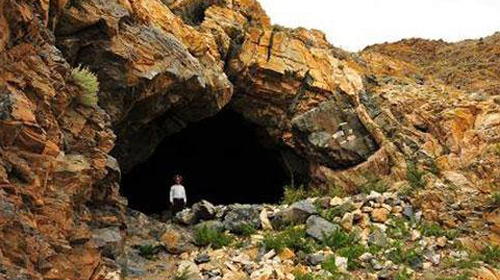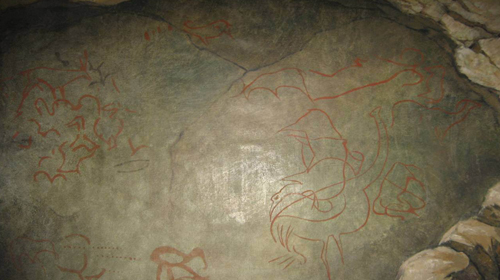
The Khoid Tsenkher cave is famous for its rock arts and is
wonderful domestic and international tourist destination. It is situated 25
kilometers away from Mankhan soum of Khovd Province. If you walk 7 kilometers
up the Tsenkher River you will directly reach the Cave. The elevation of the
Khoid Tsenkher Cave is 1571 meters above. This cave was first discovered in
1951 by O.Namnandorj who had great interest on rock art inside the Cave. Since
then the Cave has come to public attention. By that time Russian Scholar A.P.
Okladnikow placed high value on this discovery and named it “Valuable
contribution to the development of the world science” Dr.D. Maidar, a Mongolian
researcher described the rock arts be the most astonishing among the Stone age
findings. The Khoid Tsenkher Cave looks like it has two entrances as the half
of actual entrance is sealed with rocks, stones felling off the top and bird
faces. The height of the Cave is 20 meters. There are a number of long domes
hanging down the ceiling.

These rock arts have been fingerprinted in many parts which
tell us that the art may belong to Paleolithic era, during which people had
used their finger to form rock art. Depiction of ox on rock is somewhat popular
during primitive society in France and Spain. Spruces grown around the Cave
area are very commonly seen at European old stone art. This means that outlook
of the artists of Stone Age was similar with those of Europe. In this view, a
conclusion that these rocks clearly demonstrate signs of formation of art of
human being was suffered from devastating ice coverage which resulted in
extinction of these animals. The rock arts have been speculated to have formed
30,000-40,000 years ago. Most interestingly, these rock arts depicting animals
of that age never portrayed human beings.
Some archeologists have discovered extraordinary settlement
and province of Paleolithic and Mesolithic Eras after Thorough research of the
Khoid Tsenkher Cave and Surroundings. In light of this, we may refer to the
Khoid Tsenkher Cave cultural and historical memory as the Cave itself along
with findings from neighboring area involves a vast territory. Scientists
consider that creation of art is specific to not only western part of
Mongolia but in Central Asia and Eastern part of Mongolia. In 1996 the UNESCO
has enlisted this amazing Cave into the World Heritage Tentative List.
The first study by Kh.Perlee in 1943 triggered off annual
expeditions in 1960-1980. A research work on seal imprints of Rashaan Khad was
produced. A research on the Bronze Age initiated in 1973-1974 by “Gurvan Gol”
expedition group, but beginning from 1980-1981 Mongol-Soviet joint expedition
continued the work. During the last expedition it was proved that the
settlement had 4 layers which are 2.5-3.5m in depth and about 2500 stone tools,
bones of several types of animals were found. The most significant find among
them was a tusk of rhinoceros. People of the Paleolithic Era who lived around
the Khentii range and Rashaan Khad had been making various flint tools in order
to hunt a khulan, a mammoth and a rhino. This ancient lifestyle was depicted on
the rock.
15000-8000 years ahead of time Central Asian climate changed
dramatically and huge animals began to die out. This forced primitive people to
hunt quicker and smaller animals. So, they came up with bow and arrow best fit
to hunt these animals. During this period people also began to move or migrate
more often. Stone tools of particular period which were found in Mongolia,
especially those called Goviin Uldets by scholars, were also found in Siberia,
Far East, North China, Korea, Hokkaido of Japan as well as Alaska of USA.